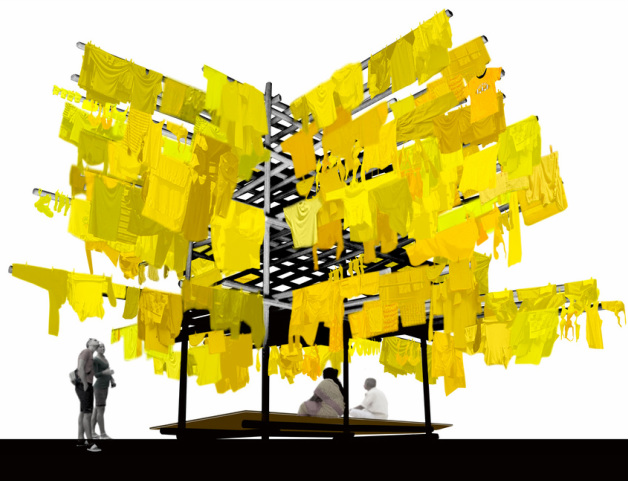|
As a kid growing up in Singapore, my mother constantly reminded me to avoid walking below dripping laundry hung out to dry from the high-rise, government subsidized apartment blocks. Besides the possibility of getting wet, she believed it would bring bad luck to the person, especially if it came from wet undergarments. I did not dare to challenge her stern advice, for fear that she may be right- at least the bad luck part...
Laundry Art consists of two proposals for public installations that speak about the multi-layers of meaning, belief and the interplay between a simple, everyday practice in the city and the process of urbanization and modernization. One can see the correlation between how clothes are washed and dried, and the social transformation of the city-state through time from the history of laundry drying in Singapore. During the British colonial era, Indian laundrymen called Dhobis would collect, wash and dry the clothes in a vacant public space before sending them back to their customers. With the advent of the washing machine and the mass housing of urban dwellers in public high-rise apartments, clothes are washed indoors and dried using a simple technique of attaching wet laundry onto bamboo poles that are inserted into hollow steel pipes outside the apartment. The practice is mostly carried out nowadays by hired domestic workers from neighboring countries or replaced by laundry dryers. The domestic workers have to get used to this practice in a relatively short time as failure to do so may result in falling to one’s death. The heavy influx of new immigrants to the city-state the past few years also meant that newcomers need to be mindful of the implicit outdoor laundry drying etiquette if they were to avoid incurring the rage of local residents. Recently, architects designed the new high-rise apartments by cleverly shaping the building façade to hide this unique practice. It was deemed that wet laundry sticking out of government subsidized housing blocks is ugly, a nuisance, and potentially dangerous. Perhaps even a sign of backwardness? In a sense, what began as a practice, which took place outdoor and presented in full view of the public has been interiorized and gradually made invisible in Singapore as the city-state constructs with ambition, vigor and unsentimental pragmatism towards the future. |
Archives
August 2023
Categories
All
|


 RSS Feed
RSS Feed
